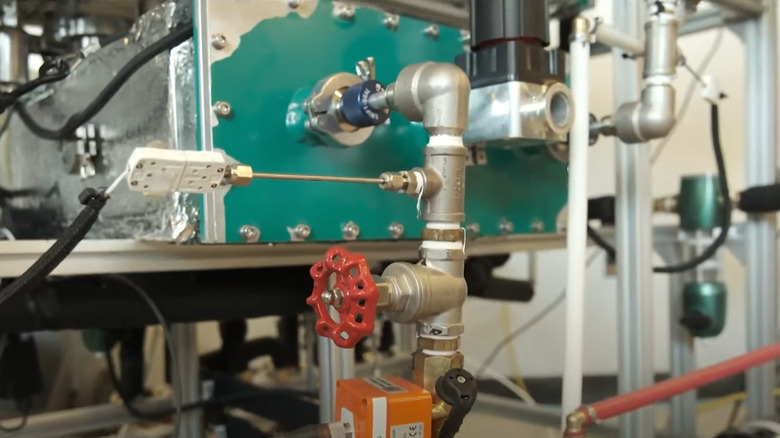The Revolutionary Prototype That Very Well May Change The Future Of Air Conditioning
Staying cool in the summer and warm in the winter seems more impossible every year. As the climate continues to change, many homeowners are looking for new ways to bring eco-conscious design into their homes, which includes air conditioning. At Simon Fraser University in British Columbia, Canada, a research team led by Majid Bahrami is striving to change the way we heat and cool our homes. This team has developed the sorption heat transformer and thermal storage system (SORT), a revolutionary prototype alternative to standard air conditioning systems. This system relies on hot water for heating and cooling, and it may very well change the future of air conditioning.
When you press a button on your thermostat, signaling it to cool your home, your air conditioner kicks in to gear, cycling refrigerant through a compressor, a condenser coil, and an evaporator coil. This process sucks the hot air from your home, replacing it with cooler air, which is great for you, but not so great for the environment. Standard air conditioning systems are electricity hogs that rely on what's termed "dirty energy" sources like coal and gas, but with climate change growing dire and more people searching for clean power sources, SORT could be a game-changer.
How the sorption heat transformer and thermal storage system (SORT) works
Concepts such as sustainable architecture are becoming more popular, so a push to reevaluate the heating and cooling systems is an inevitable next step. Bahrami and his team are preparing to take that step with SORT. In standard air conditioning systems, the evaporator coil draws in air, the heat from which is absorbed by the refrigerant, converting the refrigerant from a liquid to a gas. That gas' volume is decreased by the compressor, raising its temperature and pressure before passing it off to the condenser, which offloads the refrigerant's heat on the air outside your home, lowering the refrigerant's temperature and converting it back to a liquid.
Rather than relying on a chemical like refrigerant, the SORT prototype uses hot water. This flows through a shell-and-tube heat exchanger. Accordingly, this allows the larger mechanism to not only heat or cool the air, but to store energy that would allow for faster heating and cooling of spaces without the same waste heat produced by air conditioners.
SORT could save homeowners money and reduce air pollution
Homeowners desperate to cool down without receiving a massive bill from their power utility are constantly searching for the most cost-effective ways to run an air conditioner in the hotter months. Even with DIYs and meticulous energy-saving practices, heating and cooling a home can be a challenge. Plus, it's hard on the environment, which makes a system like SORT appealing to many.
SORT is currently displayed at Burnaby City Hall in British Colombia, showcasing not only its heating and cooling abilities but its energy efficiency, as it is directly connected to the district's energy system. While the project is not yet scalable for household use, Bahrami and his team are striving to make the system available as soon as possible, with real-world trials planned for 2026. As a part of their testing initiative, the team hopes to incorporate the system into one of Burnaby's community centers, exemplifying their community-first approach. As the SORT system is scaled down for household use, the team is focused on supporting Canada's 2030 Emissions Plan, which strives to provide clean air to the people of Canada, with a 2050 goal of net-zero emissions. SORT isn't just for Canadians, however. Bahrami's own goal for the project is to take it worldwide, providing an affordable and clean way to stay comfortable year-round.


